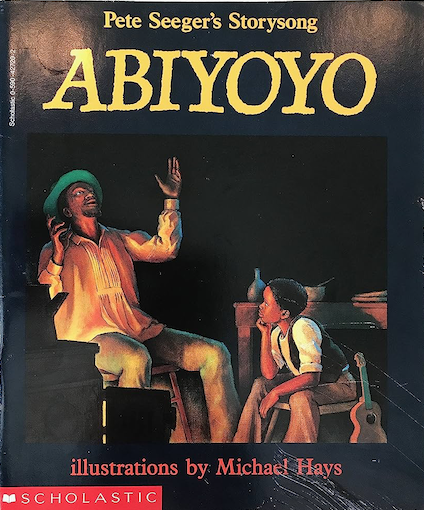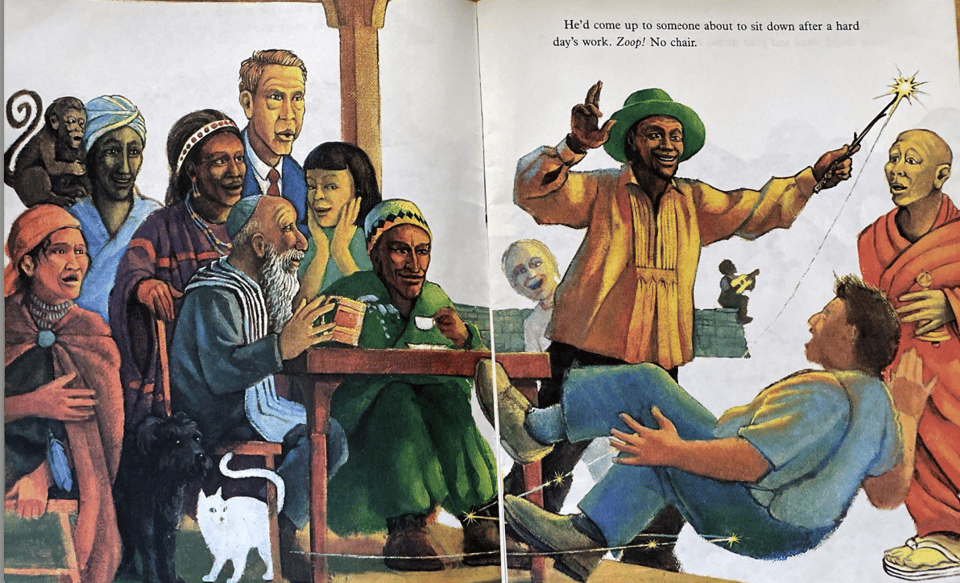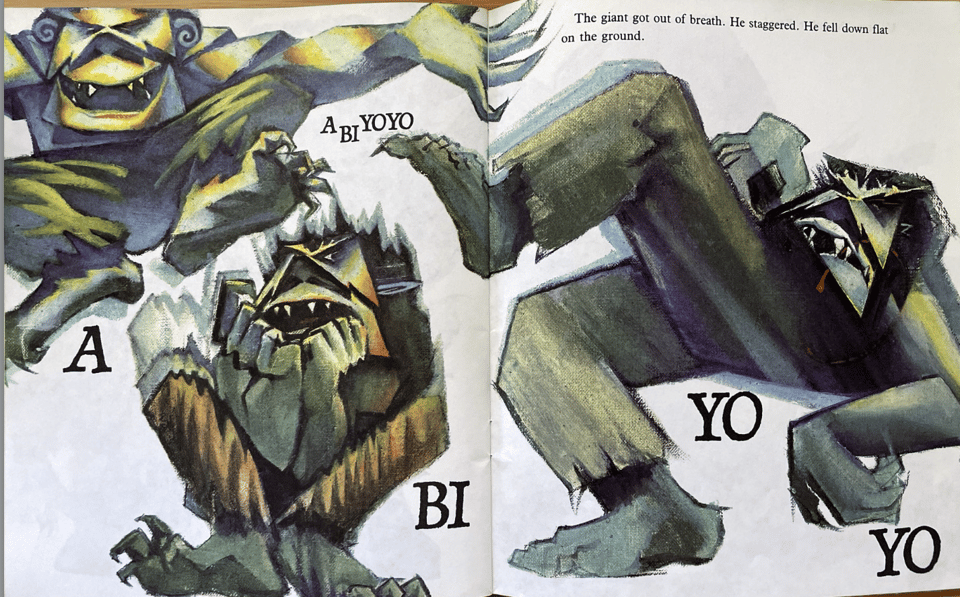Abiyoyo
Abiyoyo by Pete Seeger, illustrated by Michael Hays
Read for: A fun read-aloud book for kids; a funny glimpse into 1980s aesthetics; a surprisingly profound insight into grown-up psyches
One sunny day, I’m browsing the library book sale when a book makes me pause. A-bi-yo-yo. These are not random syllables my tiny housemate has been stringing together for the last two months. This is a real book she’s been reciting from memory.

Abiyoyo is a character in a South African (Bantu) lullaby, sung to lull the giant to prevent it from stealing trouble-making kids. This version of the story was written by folk singer Pete Seeger in 1963, who extended the oral storytelling tradition by making a few modifications of his own; the book with illustrations was later published in 1986.
The book starts by introducing a village and the village nuisances — a ukulele-clanking young boy and his prankster magician father. They annoy the villagers, who wear a rainbow of traditional outfits and represent many races and ethnicities.
One day, a giant looms at the edge of town, scooping up whole cows and sheep as the villagers panic. The village nuisances save the day by playing to their strengths — the boy tires out the giant by singing Abiyoyo’s name repeatedly, and the father ✨“zoops”✨ with his magic wand to make the giant disappear. They become the town heroes, as everyone sings “A-bi-yoyo, A-bi-yoyo…”
It’s easy to see why kids love this book. It’s undeniably silly, as you repeat ✨“zoooooop”✨ and sing “Abiyoyo” dozens of times. The illustrations are a little strange, which makes them strikingly memorable. It makes for fun games. One preschooler was listening intently into a toy phone before yelling "...ABIYOYO'S COMING!!" and sending kids scattering across the playground.
What giants and goblins have in common 👹
I’ve found the book to be a good mental model for adult life, too. The strange thing about a sabbatical, which everyone says you should enjoybecauseyou’llnevergetthistimeagain, is how good you get at goblin-wrestling. Goblins are the unformed worries and fears that circle in your head, too big and weird and vague and dumb to say to anyone else.
So, the more I read this page, the more profound it becomes:
“Well, you know, the giant had never heard a song about himself before. A foolish grin spread over his face. And the giant started to dance.”
 Just like with Abiyoyo, one way to neutralize goblins is to sing their names out loud, over and over again. Preferably in a way that makes them sound as goofy as possible. You can’t really say [deep dark fear] + “goblin” without laughing a bit as you admit your feelings to someone you trust.
Just like with Abiyoyo, one way to neutralize goblins is to sing their names out loud, over and over again. Preferably in a way that makes them sound as goofy as possible. You can’t really say [deep dark fear] + “goblin” without laughing a bit as you admit your feelings to someone you trust.
“I’ll never be able to get through a presentation without messing up goblin.” “I might be a bad friend goblin.” “I haven’t had a full-time job in one year goblin.” “Um, actually, this is too much work for me to handle goblin.”
What’s tricky about goblins is that they don’t present as fears. That would be too easy. They present as hard truths about reality, with menacing and monstrous stares.
But secretly, they love to hear songs about themselves, their goblin stares dissolving into silliness as they dance their way into exhaustion.

That’s when you can channel the prankster magician father by making them disappear* with a ✨“zoooooop!”✨
P.S. This odd book makes for a decent preschooler birthday party theme! Storytime + special guitar musical guest + Abiyoyo hand puppets = sneaky fun before strong marketing-influenced preferences take hold.
* In the case of goblins, they don’t disappear but do become more manageable.
Read with:
🎥 The 1986 Reading Rainbow edition of Abiyoyo, read and sung by Pete Seeger
📕 Chapter 2 (Decoding Fear) from The Light We Carry by Michelle Obama
📃 Make Friends With the Monster Chewing on Your Leg, and Other Tips for Surviving Startups
📕 King Leopold’s Ghost by Adam Hochschild, about the unique brutality of Belgium’s King Leopold II and his creation of a private, highly extractive colony in the Congo. This book has nothing to do with Abiyoyo, but they have one thing in common: They were both written based on a single footnote the author read elsewhere. I love how much creativity and imagination comes out of that attention to detail!
📃 On wisdom: "You can't reach the brain through the ears"
📃 Ted Chiang’s short story The Truth of Fact, the Truth of Feeling, which includes a storyline about the shift from oral tradition to reading & writing (wikipedia summary here)